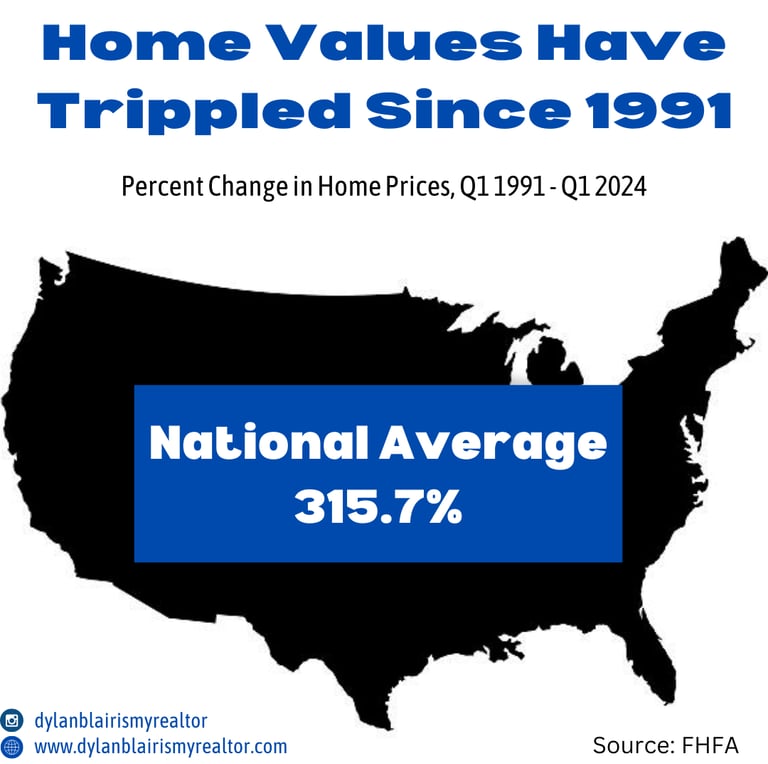Home Values Have Tripled Since 1991: A Look at the National Real Estate Market
Explore the impressive growth in home values across the United States over the past three decades. Learn how this significant appreciation impacts homeowners and potential buyers.
Dylan Blair
8/2/20242 min read


The real estate market in the United States has seen remarkable growth over the past few decades. According to the Federal Housing Finance Agency (FHFA), home values have tripled since 1991, with a national average increase of 315.7% from Q1 1991 to Q1 2024. This substantial appreciation highlights the enduring value of real estate as an investment and underscores the benefits of homeownership.
The Journey of Home Values
In 1991, the real estate landscape was vastly different. Home prices were significantly lower, and the market dynamics were shaped by the economic conditions of the time. Fast forward to 2024, and we see a transformed market where home values have increased over threefold. This growth can be attributed to several factors:
Economic Growth:
The U.S. economy has expanded considerably over the past 30 years, driving demand for housing and increasing home values.
Population Growth:
The population has grown, leading to higher demand for housing. Urbanization and the growth of metropolitan areas have further fueled this demand.
Inflation:
Inflation has played a role in increasing home prices. As the cost of living rises, so do property values.
Low Interest Rates:
Periods of historically low mortgage rates have made home buying more accessible, increasing demand and driving up prices.
Housing Shortages:
In some areas, housing supply has not kept pace with demand, leading to competitive markets and higher home values.
The Impact on Homeowners
For homeowners, this dramatic increase in home values is a significant advantage. The growth in home equity provides financial security and opens up various opportunities:
Increased Wealth:
Homeowners have seen their net worth grow as their properties appreciate. This increased wealth can be leveraged for other investments or financial goals.
Access to Home Equity:
Homeowners can tap into their increased home equity through loans or lines of credit for home improvements, debt consolidation, or other expenses.
Retirement Planning:
The appreciation in home values can play a crucial role in retirement planning. Downsizing or selling a high-value property can provide substantial funds for retirement.
What It Means for Potential Buyers
While the increase in home values is great news for current homeowners, it presents challenges for potential buyers:
Affordability:
As home prices rise, affordability becomes a concern for many buyers. It is essential to plan and budget carefully when entering the market.
Investment Potential:
Despite higher prices, real estate remains a solid long-term investment. Understanding market trends and working with a knowledgeable real estate agent can help buyers make informed decisions.
Conclusion
The tripling of home values since 1991 underscores the strength and resilience of the U.S. real estate market. For homeowners, it highlights the wealth-building potential of real estate. For potential buyers, it emphasizes the importance of strategic planning and investment. Whether you're looking to buy, sell, or simply understand the market better, the data shows that real estate continues to be a powerful asset in building financial security and growth.
If you're interested in learning more about the current real estate market or need personalized advice on buying or selling a home, feel free to reach out. Let's navigate this dynamic market together!

